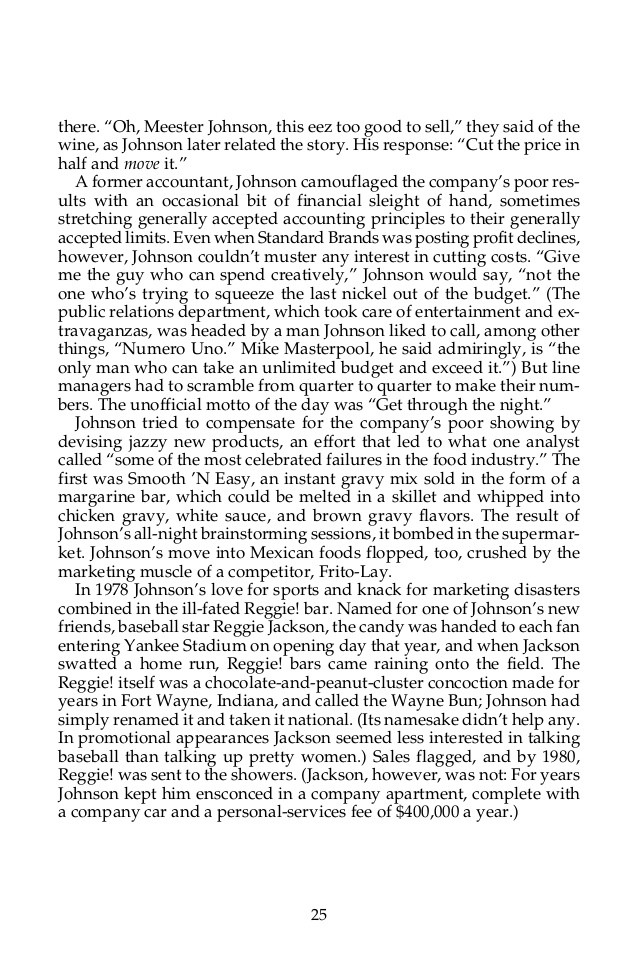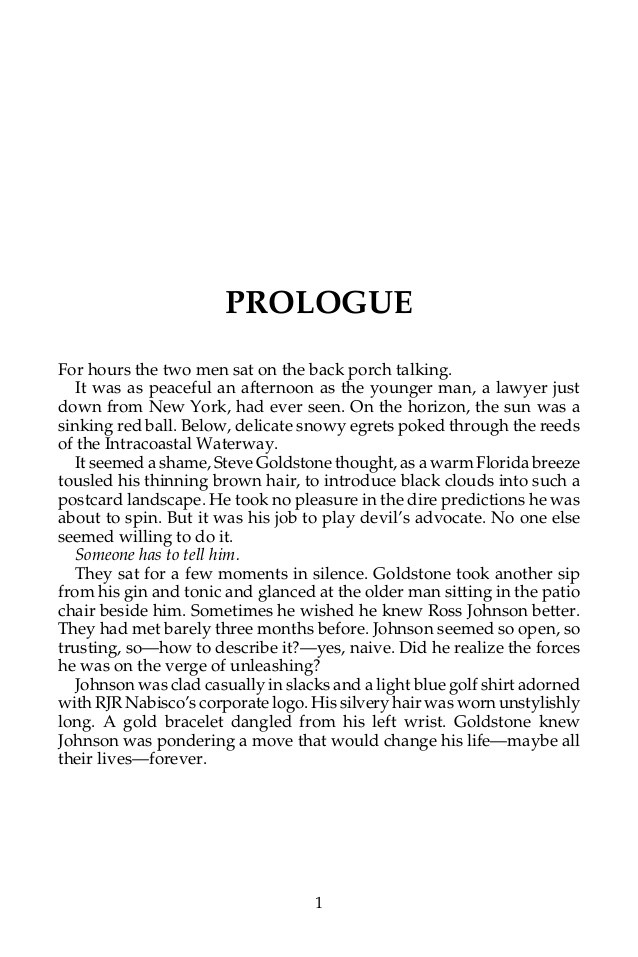Gary Black RJR Nabisco ValueUnlocking 101 Selling Reynolds International Won
Post on: 27 Апрель, 2015 No Comment

Gary Black: RJR Nabisco: Value-Unlocking 101 — Selling Reynolds International Won.
TOBACCO
RJR Nabisco: Value-Unlocking 101 — Selling Reynolds International Won.
Gary Black (212) 756-4197
February 8, 1999
HIGHLIGHTS
- Selling RJR International outright, either for cash or stock, will not help RJR’s valuation. The cash or stock received in a sale would still be locked up under the parent’s tobacco liability umbrella — hence, be valued at RJR’s current depressed multiple. A sale for cash or stock would destroy the company’s ability to distribute to shareholders the value of RJR International tax-free.
ADDITIONAL DETAILS

- Getting tobacco for free again.
For the first time since last Summer, RJR Nabisco is again being valued ($8.8 billion, or $27.25/share) at below the value of the Nabisco marketable securities held (Nabisco shares worth $9.1 billion, $28.08/share). Put differently, RJR could self-tender for all its RJR shares at $28.08/share, and use the Nabisco securities to pay for the tender — giving management the worldwide tobacco company, with $2.50 in cash earnings each year — for free. On an unlevered basis (including $6.5 billion in tobacco debt securities), the market appears to be valuing worldwide tobacco at $6.2 billion, vs. 1999E EBITA of $2.1 billion (3.0x EBITA). This is like saying that RJR’s worldwide tobacco business will go bankrupt in 3 years.
An alternative explanation, to which we subscribe, is that investors, in putting a 12.4x (46% relative) multiple on tobacco, are also putting a 12.4x (46% relative) multiple on the Nabisco marketable securities that could be seized by tobacco plaintiffs if the tobacco company went bankrupt under the weight of thousands of potential tobacco claims filed. Near-term, it doesn’t seem to matter to investors that, with the recent ruling overturning the Maddox case, the industry has never lost a case at trial. Or that in most tobacco claims, the RJR parent — owner of the $9.1 billion in Nabisco securities — has been dismissed as a defendant. In essence, the market attaches the same probability of bankruptcy to the Nabisco securities held by the parent that it puts on RJR tobacco itself — which suggests that the only way to boost the stock price is to extract Nabisco completely from the tobacco taint.
It might be helpful to review the composition of RJR Nabisco, before getting into a discussion on how value might be unlocked. RJR Nabisco is a holding company which owns two distinct assets: The first is a worldwide tobacco company that earned $1.30 in reported earnings and $2.40 in cash earnings in 1998, has $6.5 billion in net debt, and covers its fixed charges some 3x. The second asset is $9.1 billion in Nabisco marketable securities (worth $28 per RN share), which investors should view as cash and marketable securities, given management’s intent to distribute these marketable securities once the uncertain legal risks dissipate. The IRS holds that as long as a parent company owns at least 80% of the voting stock, has held the stock for at least five years, and has a legitimate business reason for divesting these securities, the marketable securities may by distributed tax free to shareholders. The U.S.Treasury Department is currently reviewing the tax-free treatment of spin-offs, given the view that a spin-off is more akin to a dividend (which is taxed) than one stock being replaced with two separate stocks. We doubt the Treasury’s new proposal will get off the ground.
There are four ways to separate RJR Tobacco from Nabisco. The first, which we favor, is an outright spin-off of Nabisco — worth $42-$43: The value of RJR’s Nabisco shares if unshackled from tobacco is $28 per RN share (.65 x $43/share). RJR owns 213.25 million Nabisco shares, and there are 324.2 million RN shares (213.25 / 324.2 = .65 NA shares per RN share). One can compute the value of worldwide tobacco in one of two ways: Under the first, we would attach to the tobacco business the P/E or cash P/E one sees on the RJR parent — 12.4x and 7.3x, respectively. Intuitively, this makes sense to us since the market appears to put the least common denominator of bankruptcy risks on all components of RJR Nabisco. At even a -2.0 multiple point discount to the current parent multiple (theory might be that a standalone tobacco will have more financial risk than one that has a $9.1 billion cash cushion), a multiple of 10.4x the tobacco stub’s 1999E earnings of $1.40/share gives us $15/share, or $43 in total RJR value. A second way to value tobacco is to attach the BAT proforma purchase price for Rothmans (5.5x EBITDA) to RJR’s worldwide tobacco business, assuming that a new buyer will not get synergies. An EBITDA multiple of 5.5x @ $2.1 billion, less $6.5 billion in net debt, equals $5.1 billion, which equals $16/share. The difference between RJR and Rothmans, of course, is that owning Rothmans did not pose litigation risks..
The second way to separate RJR tobacco from Nabisco is to sell Nabisco outright for fair consideration, and simply pay the capital gains tax. The problem with this approach, is that even if RJR netted $42 per Nabisco share after tax (could avoid capital gains if sold for stock), RJR cannot distribute the cash (or stock) to unlock the Nabisco value without incurring fraudulent conveyance risks, with which the Board is simply not comfortable. As we have said before, the current RJR board is unlikely to approve a spin-off until there is closure to this litigation wave, which is unlikely until the industry agrees to a new federal settlement, with offsets (reduction in payments) for all remaining litigation risks
A third option for separation is to sell domestic tobacco outright, to a buyer willing to assume all existing and unmatured liabilities, and indemnify the corporate parent against future litigation losses. Unfortunately, no one other than LeBow’s Liggett Group seems willing to assume RJR’s share of industry liabilities, which are disproportionately larger than RJR’s current market share. In addition, any would-be buyer would need the financial credibility to indemnify the RJR parent; other wise the Board would still be leery of spinning off Nabisco, given continuing litigation risks at the parent level.
The fourth way to separate tobacco from Nabisco is to simply spin off RJR worldwide tobacco to the shareholders. Unlike a spin-off of Nabisco, this would not pose fraudulent conveyance risks, since no assets would be stripped from the tobacco liabilities, which would still reside at both the tobacco subsidiary and the corporate level. Initially, the tobacco stock distributed and the parent stub ($9.1 billion Nabisco securities) would likely trade at the same 12.4x multiple at which the RJR parent trades now. However, we believe that over time, the RJR stub, whose sole assets would be a controlling interest in Nabisco (213.25 million shares, or 80% of Nabisco stock), would not trade for 36% (12.4x / 34.1x) of a pure Nabisco — which would imply that soiled Nabisco share would trade for $15/share. Given two options — pure Nabisco at $42/share, and soiled Nabisco, which shares the RJR parent’s tobacco litigation risks, for $15/share, we believe arbitrageurs would bid up the soiled Nabisco. The problems with this approach, which both Philip Morris and Loews have considered and rejected, is that plaintiffs would file additional lawsuits filed against the RJR parent and Nabisco. It would also create conflicts between the separate boards at the separate companies. Each board could blame the other for wrongs alleged in the claims filed; one board might decide to settle, which might pressure the other to do the same, even if it wanted to fight.
- Selling RJR International adds nothing to RJR’s value.
As we have spelled out on several occasions over the past six months, selling RJR International outright, whether for cash or stock, does little for RJR’s valuation. Analysts who have postured that a sale of RJR Intentional will add anywhere from 10-25% to RJR’s stock price appear to have overlooked the IRS guidelines on tax-free restructurings, or may not understand the principles of fraudulent conveyance.
Selling RJR International outright does not work for three reasons: First, and most importantly, the cash or stock received remains locked up under the corporate parent’s umbrella, which, in this case, is contaminated by tobacco liability. Like Reynolds International, the cash or stock received would still be subject to tobacco liability risks, and hence, be valued the same as the Reynolds International business sold. Second, such a transaction would forever destroy RJR’s ability to spin off to shareholders the value of Reynolds International in a tax-free reorganization. Third, unless the purchase price exceeded 12-13x EBITA (about $6 billion), the transaction would almost surely be dilutive, since the cash proceeds (or preferred dividend if preferred stock was used as currency) would likely be used to retire or service debt at 7-8% pretax.
Why would a sale of Reynolds International for stock — which would allow RJR Nabisco to avoid a capital gain — forever destroy shareholders’ ability to receive the value Reynolds International tax free? The IRS rules on tax-free reorganizations hold that a spin-off (distribution of Nabisco equity) or split off (buying in RJR’s own stock, and using Nabisco securities as currency) will only be treated as a tax-free reorganization if a) there is a legitimate business rationale for the transaction; b) the parent owns 80% of the voting control of the stock, and c) the stock has been held by the parent for at least five years. If RJR Nabisco were to sell Reynolds International for stock, and another company’s stock was received in exchange, the last two conditions for a tax-free reorganization would be breached, and any subsequent distribution of the stock would be taxable.
www.tobacco.org/News/blackf/990208black.html














